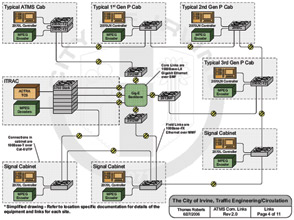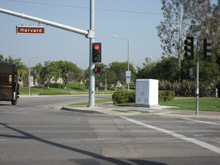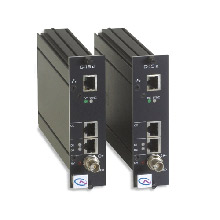 The City of Irvine, incorporated in 1971, is, according to their website, "...one of the United States' largest planned urban communities and encompasses more than 65 square miles." Part of Orange County in Southern California, Irvine is populated by more than 200,000 people making between 10,000 and 70,000 average daily travel trips.
The City of Irvine, incorporated in 1971, is, according to their website, "...one of the United States' largest planned urban communities and encompasses more than 65 square miles." Part of Orange County in Southern California, Irvine is populated by more than 200,000 people making between 10,000 and 70,000 average daily travel trips.
One of the primary ways the city is keeping its citizens moving is through the use of traffic surveillance cameras and advanced traffic controllers deployed at its 300+ signalized intersections; Irvine's plan is to accommodate up to 500 intersections before the City's final development plan is built-out.
Network challenge
Like many cities and transportation agencies around the world, the City of Irvine had a complex problem: how do you take disparate, incompatible communication systems and migrate them all on to one open, standards-based network? At the end of 1997 the City of Irvine faced this challenge head-on.
There were six primary areas of concern driving the convergence:
- Core network - ATM with LAN Emulation (LANE)
- Analog video switching
- Video surveillance - home run, dedicated fibre, copper, and wireless links for CCTV
- Traffic controllers - proprietary FSK modems using copper twisted pair
- Traffic signal management - proprietary central traffic control system
- Redundancy/resilience - all systems were a "single point of failure"
The City of Irvine met this multi-faceted traffic network challenge by coming up with one of the most forward thinking solutions available at the time.
Network solution
Irvine's first hurdle involved their ATM network core. As many are aware, ATM-based optical networks have many positives and negatives. While they are quite adept at handling video content and guaranteeing Quality of Service (QOS), ATM as a standard has proven too difficult to deploy and support because many manufacturers have learned that the cost of competing against other networking methods is just too difficult.
Irvine quickly realized this and decided to completely migrate their network core toward an Ethernet solution. After extensive research in vendors and equipment, they decided to build their architecture on a Cisco Systems platform. They chose the Cisco Catalyst 3750 series for the core moving data at rates up to 10 Gbps. The network edge, with switches in every traffic signal cabinet, is driven by the Cisco Catalyst 2955, which is a temperature hardened Layer 2/3 switch for rates up to 1 Gbps.
This new approach gave Irvine a number of new advantages:
- One protocol from edge to core
- Reduced network node cost
- Improved scalability
- Increased bandwidth capability
- Interoperable network components based on Ethernet

So as Irvine's network grew, adding new capabilities was simply a matter of ensuring Ethernet connectivity. For their Traffic Controllers Irvine chose the Siemens 2070 Lite with integrated Ethernet connectivity. For networked video transmission they decided on MPEG-2 using Siqura C-15 video encoders and decoders.
Specific to the video surveillance portion of Irvine's network, there was a need to replace their old method: dedicated fibre point-to-point runs moving baseband video signals to the Traffic Management Centre. To replace this inefficient method of using fibre assets, they chose to compress their video camera signals using Siqura C-15 codecs capable of networking video at multiple rates using MPEG-2. These temperature hardened Siqura codecs equipped the city with high-quality video without the need for dedicated transmission paths. By connecting these codecs to field Ethernet switches, Irvine was able to make any video signal available to the viewer using both hardware and software decoding as long as network connectivity and IP addresses were available.
 Thomas Roberts, Senior Project Manager for the City of Irvine, said, "Converging all of our communications requirements onto a common platform presented a real challenge. The benefits of our Ethernet-based system have far exceeded our expectations in terms of performance, reliability, redundancy, and expandability. Siqura has been an integral partner. Not only do their products work well for us, but we have come to appreciate their high level of service and proactive support."
Thomas Roberts, Senior Project Manager for the City of Irvine, said, "Converging all of our communications requirements onto a common platform presented a real challenge. The benefits of our Ethernet-based system have far exceeded our expectations in terms of performance, reliability, redundancy, and expandability. Siqura has been an integral partner. Not only do their products work well for us, but we have come to appreciate their high level of service and proactive support."
Irvine believes their Ethernet network architecture will provide them unparalleled expandability, freedom from proprietary solutions, and will ease integration of future technologies. The ITS industry in general is quickly realising what IT professionals discovered long ago: Ethernet and IP make a perfect platform for converging disparate communications systems into a unified, manageable, open solution.
















